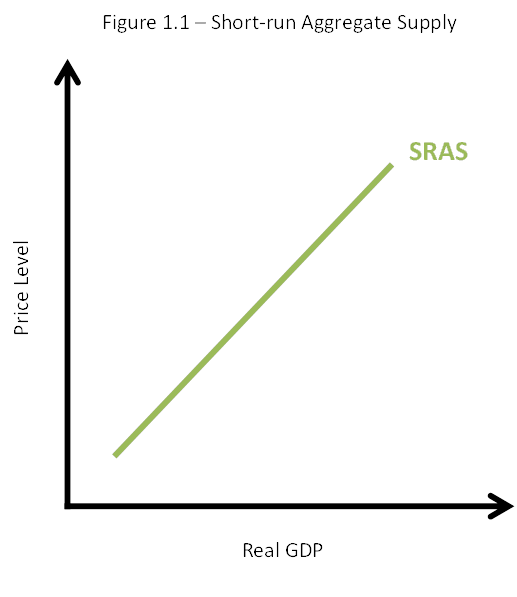The short-run aggregate supply (SRAS) curve shows the relationship between the total quantity of goods and services produced in an economy (real GDP) and the price level during a time period when resource prices remain constant or highly inflexible.
Long-run and short-run
The economy is characterized by its production in the long-run and the short-run. The short-run is a period of time where resource prices are constant. This is because factors such as minimum wage laws, labour contracts and workers unions prevent wages from responding quickly to changes in the economy. Thus, wages are commonly referred to as being “sticky.”
Slope of the SRAS curve
Figure 1.1 shows an SRAS curve. The upward slope of the curve indicates that producers will increase the quantity of goods and services produced in response to an increase in the price level.
As wages are sticky, an increase in the general price level will allow firms to sell their products for higher prices while maintaining constant costs of production. This will result in higher profit margins and encourage firms to increase their output to take advantage of higher profits.
Similarly, a fall in the price level would result in lower profit margins and a decrease in output.
Shifts in the SRAS curve
There are several important factors which can cause a shift in the SRAS curve as illustrated in figure 1.2. Most factors are related to changes in the costs of production.
When wages rise or fall, ceteris paribus, firms’ costs of production rise or fall in the same direction. A rise in wages causes an inward shift of the SRAS curve from SRAS0 to SRAS2 and a fall in wages causes an outward shift of the SRAS from SRAS0 to SRAS1.
The price of non-labour resources such as crude oil, machinery, and metals affect the costs of production in the same manner as wages. Therefore, an increase in the price of a resource causes an inward shift of the SRAS curve, and a decrease causes an outward shift of the SRAS curve.
Indirect taxes such as sales tax are paid to the government by the firm. This means that for any level of output, the firm must receive a price which is higher than the original price by the amount of the tax. In the aggregate, the effect is an increase in the general price level. Thus, higher indirect taxation causes an inward shift of the SRAS curve, and lower indirect taxation causes an outward shift of the SRAS curve.
Subsidies are paid by the government to firms. This means that for any level of output, the firm will charge a price which is lower than the original price by the amount of the subsidy. In the aggregate, the effect is a decrease in the general price level. Thus, higher subsides cause an outward shift in the SRAS curve, and lower subsidies cause of an inward shift in the SRAS curve.
A supply shock is a temporary and unexpected event which has a strong and sudden impact upon the SRAS curve. Negative supply shocks cause an inward shift of the SRAS curve. For example, a war which affects the price of crude oil. Positive supply shocks cause an outward shift of the SRAS curve. For example, unusually good weather conditions which result in higher crop yields.
Author Profile

- Luke Watson has a BSc (Hons) in international business and economics. He is currently working as an IBDP economics teacher at Shanghai United International School in China.
Latest entries
- March 10, 2023CourseHow the Fed Sets Interest Rates Post-Crisis
- February 5, 2023CourseHow to Calculate the Gini Coefficient Using the Lorenz Curve
- January 29, 2023CourseHow to Score Full Marks on the Economics IA
- January 29, 2023CourseHow to Effectively Structure Your Economics IA







Comments are closed